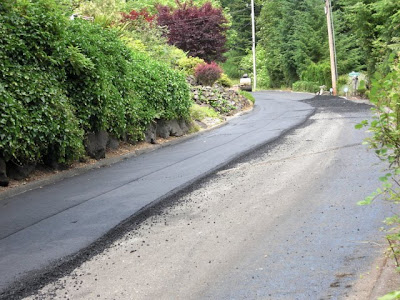
Baja Vista after paving

Alta Vista after paving


 Quite a process!
Quite a process! 
Pictures and commentary by "Keith" -
Before the paving starts, a gooey liquid substance is sprayed on the right and left side of the road but not the middle. The asphalt is 300 degrees when it is loaded into the dump trucks at the factory (I don't know where that is). When it gets here, the truck is skillfully backed up to the front end of a machine I call the paver. The front end of the paver is equipped with something like crabs claws which are opened to receive the load from the rear of the dump truck.
The truck and the paver look like they become one machine as they both creep down the street, with the hot asphalt dumping into the paver's front end and coming out the paver as 2" think roadway. The paver can pave up to 4" thick. After the dump truck empties it's load, the "claws" of the paver close up so that more paving material is forced into the paver's machinery. Another dump truck is soon backed up and the paver and the claws open up again.
 As the roadway is laid, one operator uses a testing tool to monitor the depth of the
As the roadway is laid, one operator uses a testing tool to monitor the depth of thepaving. Another operator steers the machine along the edge of the road (in our case, the curb) and constantly signals the truck driver to raise or lower the dumper of the truck to keep material flowing out of the truck.
 After the paver goes by, a man comes along with a small compactor to compact the asphalt along the curb. Meantime, a roller works its way up and down the street to compress any seams and to smooth the roadway to a better degree. If any gaps are found the paving (as happened on Marine View, all the crew members carry shovels full of asphalt and fill in the hole, which is then compacted by the roller.
After the paver goes by, a man comes along with a small compactor to compact the asphalt along the curb. Meantime, a roller works its way up and down the street to compress any seams and to smooth the roadway to a better degree. If any gaps are found the paving (as happened on Marine View, all the crew members carry shovels full of asphalt and fill in the hole, which is then compacted by the roller.  It was quite a process and I enjoyed watching it. The roads look great.
It was quite a process and I enjoyed watching it. The roads look great.